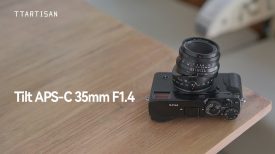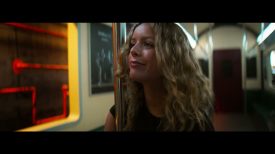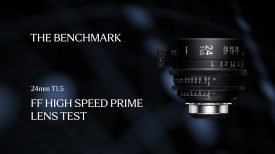By site editor Dan Chung:
The New York Times Op-Docs series is one of the premier outlets for documentary makers trying to get their work seen. Christoph Gelfand and Caroline Losneck of True Life Media recently had their short ‘Diving for Scallops’ featured. It tells the story of James Sewell, a Maine scallop diver who has overcome physical hurdles. It is shot above water on a Sony a7S and below by Heeth Grantham on a Canon 5D mkIII. We spoke to them about how the process of creating the doc:
What’s your background in video? Tell me about True Life Media.
CG: I went to film school and have been making documentary films since I was a child. I started off in the industry mixing location audio but really wanted to get back to making my own films. In 2006, I started pushing myself to land more True Life Media-oriented work and began making doc work for some nonprofits. I also produced a short documentary, Chasing Buckner, which detailed my very personal attachment to one player’s plight after the 1986 World Series and gained some great attention.
In 2013 I moved to Portland, Maine and met Caroline Losneck, who produces pieces for Marketplace and Maine Public Radio as well as her own projects. Her independent spirit led me to believe we would pair well and our audio/video installation Fyke Tide debuted to great acclaim at the Camden Film Festival. Since then we’ve collaborated on several projects.
What drew you to this subject?
CG and CL: We seem to be magnetically drawn to the water – in particular, our local waterways and the people making a living on them. We live in southern Maine, and despite living so close to fisheries and active working waterfronts, it is surprisingly easy to not notice them if you aren’t looking.
Caroline was researching a radio story when she learned about divers who dive to the ocean floor and hand pick scallops. We heard about James Sewell and his story was compelling on multiple levels: Here’s a man who not only dives deep into the cold Maine waters to hand harvest scallops, but still persists after a serious accident. We wanted to see him work, ask him questions, and pay attention to the ways in which his life in the ocean has taken on greater meaning and purpose since his injury. His honesty and openness made it easy to document him and his work.
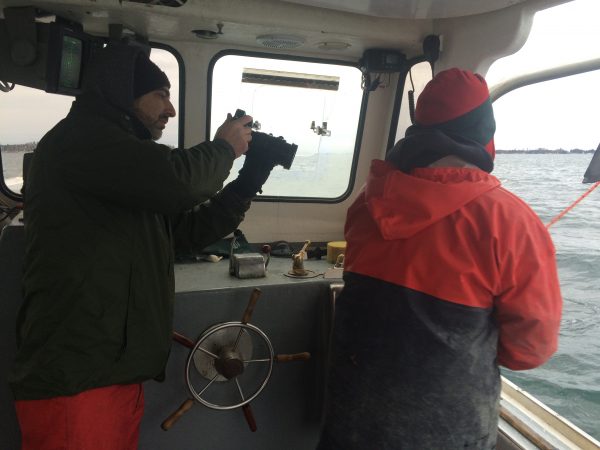
How did this end up on the Times? Did they commission it or did you pitch it? Did you know someone there?
CG and CL: We knew the NYT Op-Docs series was the right fit for the type of storytelling we like to do and last year we entered another idea into its pitch competition; it was not chosen, but the commissioning producer wrote a really nice email encouraging us to stay in touch.
We pitched this story in early March and they were definitely interested, but wanted to see what we could produce before committing. So we outlaid our own money, called in some favors and shot the material in a matter of weeks. A week or two later we drove back up to Cushing, ME to interview Sewell. Overall, it was close to a six month process.
If you have an idea, even if you don’t know who you are pitching, go for it. Or better: even if you get rejected the first time, try again!
What are the constraints of doing an Op Doc?
CG and CL: The Times has guidelines around running time (typically 5-7 minutes) and exclusivity. Most significantly, they are looking for documentaries that aren’t afraid of expressing perspectives. Beyond that, they really leave it up to you.
We always wanted to let Sewell’s voice and the sounds, rhythms, and textures of life on his boat and ocean take over. The Times’ Op-Docs team were very helpful in terms of shaping the fine and final cuts and asked a lot of questions aimed at getting to the core meaning of our piece.
The Op-Docs main goal is to inspire conversation. They want to know what people will talk about after seeing your film. In our case, much of the conversation has revolved around the environmental impact of hand fishing versus dayboat fishing and the amazing risks James takes in diving for scallops with a seemingly insurmountable physical ailment.
The structure of the film is interesting. Why did you put the physical challenge stuff in the middle and not at the start?
CG and CL: We knew that a major theme would be the resilience and resolve James had to get back into the water after his accident and his constant mantra to “keep moving forward”. We also knew that we didn’t want the narrative structure to follow the familiar outline of: good man gets injured, man overcomes. We felt that we needed to show James as the complex person that he is, not simply as a person with a disability doing this amazing and dangerous work. Structuring it in this way allowed us, and audiences, to get to know him in a deeper way.
What was the rig for the 5D underwater? How deep did you have to go? Were there safety concerns?
Heeth Grantham, who filmed this material:
I used an Ikelite housing with 8″ dome port. No lights. The Max depth was ~’75. There are always safety concerns when shooting underwater, even in a pool. The shooter is dependent on his or her safety support team to bail them out in the event of a catastrophic emergency. When shooting with Sewell, I didn’t have that reassurance, as I’d never met the fishermen. Additionally, his tender’s number one responsibility was to get Jamie back on board safely. If James and I were to become separated underwater, the currents could have pushed us hundreds of yards apart by the time we surfaced. There would have been no guarantee that they’d have found me promptly.
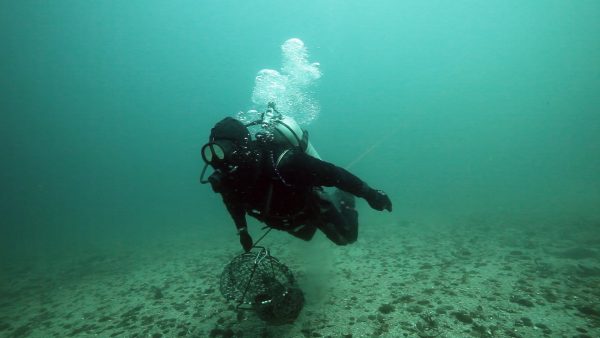
Do you have a lot of experience shooting underwater? Were there any specific challenges?
HG: I’ve been shooting underwater in Maine for more than 20 years, and have commercially dived for scallops. So I’ve got the proper gear, and understand the environment and physical difficulties. The biggest challenge was learning James’ habits and rhythm underwater. Once I did so, I could anticipate his swimming direction, and be in position to get the shots I wanted.
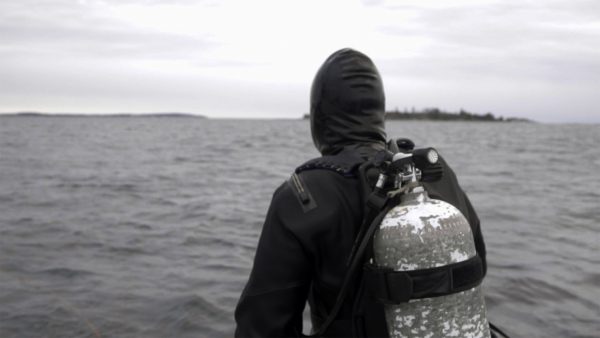
How did you find the balance between the dark and murky world underwater and the stuff on the boat?
CG: There was temptation to really overuse the underwater material because it’s just so magical and mysterious. But it became clear that underwater was this other place for Sewell and should be treated as a sacred escape in the film. Visually, it’s also a treat to move from the color scheme of stuff on the boat to this silty cloud of aquatic life. So we used underwater more sparingly.
For the stuff in the boat, was it all handheld? How did you keep the camera steady and clean and dry? Any tips for shooting on a boat?
CG: It seems insane to even consider a piece like this without some sort of stabilizer or rig, but we did. The idea was to stay small and compact without throwing my balance off. The camera had only the Movcam cage and no handle and I simply cradled the camera and braced my legs whenever we started swaying.
I alternated between Crop mode and full frame depending on how much action there was. Occasionally, I really needed the full size of the lens so I’d switch off to full frame to pull a wide. Also, the IS on both 24-105 and 70-200 II were definitely helpful to steady the image. And on a few shots I did use both FCPX’s built-in stabilizer and the Lock ‘N Load plugin.
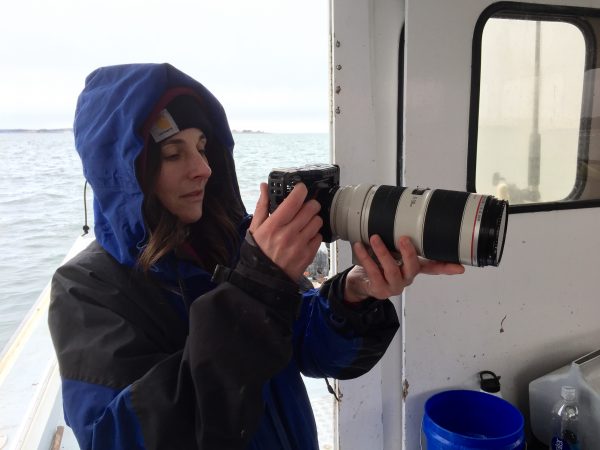
I had purchased a cover from Amazon to keep the camera dry, but found it a bit unwieldy for the speed at which I needed to operate. There was a fair degree of surf kicking up and whenever Sewell dove into the water the splash seemed to find me. I kept plenty of wipes on hand and a small hanky to quickly dry off the camera, and at the end of the shoot, I wiped it all down with alcohol.
If I had to do it again, I’d consider something else that I could use to operate and see the camera. An EVF or something that could protrude outside the cover might’ve helped, because trying to hold focus through crinkled plastic on a fishing boat at sea isn’t optimal.
Did you record everything internally? Or did you go 4K external?
CG: Everything was recorded internally. Adding additional weight felt like an impedance and possible safety risk especially with slippery decks and unsure footing. I would love to see how the a7R II holds up using internal 4k by comparison. I prefer shooting in 4k these days, but it’s a luxury we can’t always have and most material is finished in HD anyway.
Having filmed a bunch with the a7S I had confidence that the internal codec would hold up against the color grade. We shot in SLog to give some additional latitude in post. And as a rule I tried to expose to the right + 2 or +3.
The use of colour was interesting. What was the thinking behind that?
CG: One day of filming (above water) was grey and cold, and the other day (underwater) warm and sunny. We got lucky, because the 5D isn’t great in lowlight (especially underwater) and the SLog leant itself to working well with recovering highlights above water.
We started by using LUT Utility in FCPX and throwing on a few of Alister Chapman’s A7s LUTs for +2 and +3, etc just to bring back our highlights. In discussions with our colorist, Dean Merrill we decided to figure out zones for color, breaking down the film into: on the boat, in the cabin, and underwater.
My initial grade was way too heavy on the blacks, so Dean brought those up and tried to add a little warmth to the images to make them more digestible. The simple burst of orange and blue from the bib and gloves of the boat’s tender also brought some color into an otherwise black, grey, and white scheme.
In the cabin, we wanted to really highlight Sewell and somewhat obscure the background. Without much available light, I had to push the ISO on the a7S to over 10,000, while remaining all the way open on the Canon 24-105. This created a pretty bland look, so Dean had to really work to vignette Sewell and give the cabin a little bit more of a warm glow. There was a small electric lantern down there to justify the look, but I think it gives the feel that that place is his safe haven.
Underwater we didn’t have a ton of options. The footage was naturally kind of green and the 5D 8-bit codec can’t be pushed too much (certainly not like the a7S XAVC-S) so we played it safe and actually desaturated much of the footage while bringing in the blacks and adding a little blue. Heeth was shocked at how clear the water was down there, particularly considering all the sand that gets kicked up in a silty cloud when Sewell moves along the ocean floor. We really lucked out with visibility.
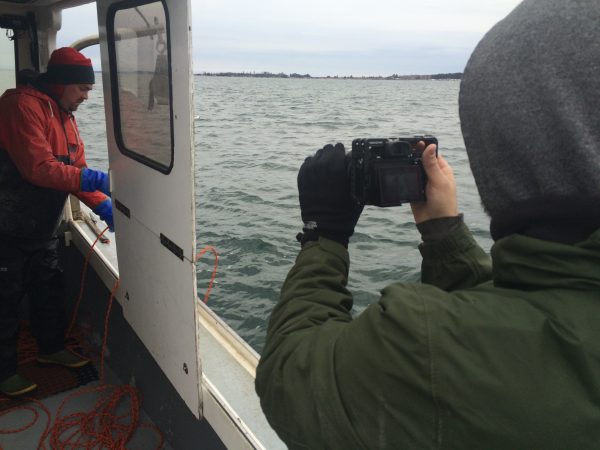
Can you tell me about the sound design of the piece? It relays a lot on audio underwater. Was this a conscious decision?
CG and CL: Caroline comes from an audio world and we both wanted a sound-rich piece. We were enchanted by the flag blowing in the wind, the boat motor, the squeaky suit, the scallops being hauled in and shucked, and, of course, the huge splash that accompanies James as he falls backward into the water. These sounds immediately place you on the boat, and you really hear and experience the world the way James does. The underwater sounds were a bit more muted, a little echoey, and maybe ominous. We wanted underwater to take viewers into the other world that it represents for James. The sound design makes the transitions more dynamic.
We worked with our post mixer, Pete Nenortas, to even out the underlying musical tone and blend effects in a way that sounded organic and lifelike. We made a conscious decision to use audio that felt real, but then in certain places (such as where the tender releases a valve on an air tank) took a little artistic license. In addition, Pete seamlessly EQed Sewell’s voice, helping to differentiate it from the low-end sounds prevalent throughout the film.
How did you handle getting the audio underwater? How did you record audio on the boat? Straight into the camera? or external audio recorder?
CG and CL: Underwater audio was a combination of the on-camera 5D mic (inside the Ikelite housing) and additional sound effects. We really liked the quality of the underwater audio, particularly when James was fastening a carabiner to a scallop bag or breathing hard. Then we layered in a ton of bubbles and rumbling effects to provide a sound bed.
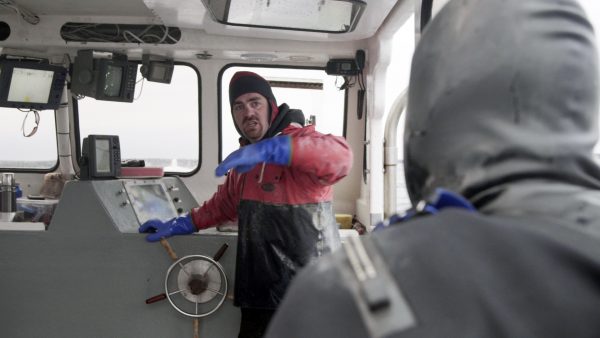
Audio on the boat was done very lightweight with a Zoom H4n and a Sennheiser MKH60 as I wanted to stay small. In retrospect, I should’ve considered bulking up with my Sound Devices 633 (which I used later to record the VO track). The Zoom, while handy for some shoots, really can’t handle tricky recording situations like the heavy rumble of a boat engine. Nonetheless, we were able to get some great effects from the boat.
Additionally, I didn’t use my K1M hotshoe mic setup for the a7S and found that the on-camera mic, even with the wind and surf, grabbed some key effects for us while recording. I do like that the camera still records audio when shooting HFR, which is really handy in case you want to match some effects to images.
Often, we found ourselves feeding pre-recorded effects into the audio software, Reaper, and slowing down the material substantially to match the imagery. This yielded some really cool results such as slow motion bubbles.
You used slow motion on the a7S? People complain it is too soft. How did you find it? Would you use it again?
CG: I’ve used the 120fps on the a7S to varying degrees of success. In certain situations I noticed some pretty harsh aliasing and even some moiré. I agree it can be pretty soft (especially since it’s 720p) but I found it to work well in this piece. We ended up slowing down a bunch of other footage to closely match the native 120p footage because it leant itself to the lyrical drawl of the film.
You shot for two days; how long did you spend putting it together? Were you satisfied with the short form of the Op Doc? Is there a longer cut? Would you go back and do a longer version?
CG and CL: The film went through about twelve edits over four months. The initial cut that we submitted was 10 minutes or so, but the Op-Docs team felt that they might prefer a shorter, more concise piece.
The challenge for us was finding a way to trim the fat while maintaining some of the intricate details we filmed. So we also produced an eight and a half minute version for film festivals, which really maintains that drawn out quality. We are elated to have been part of the NYTimes Op-Docs series and look forward to continuing the journey with the longer piece.
You can find out more about True Life Media and their work on their website.



